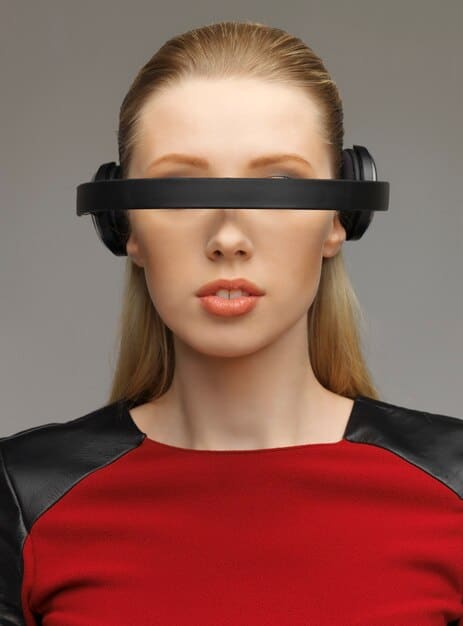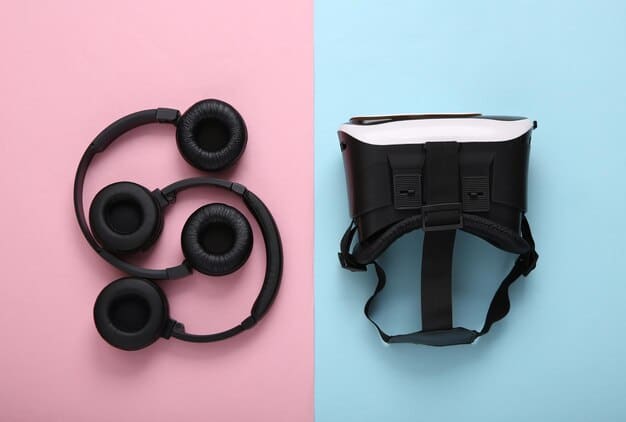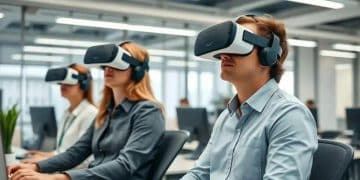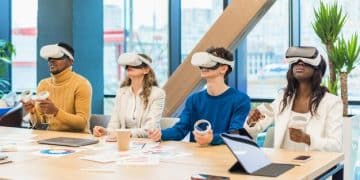VR Audio Showdown: Bone Conduction vs. Spatial for the Future of VR

The Future of VR Audio: Bone Conduction Headphones vs. Spatial Audio – Which Wins? explores two leading technologies poised to revolutionize virtual reality soundscapes, examining their unique strengths, weaknesses, and potential applications within the immersive digital world.
Step into a world where sound is not just heard, but felt. The future of VR is rapidly evolving, and audio technology is at the forefront, particularly with the ascent of bone conduction headphones and spatial audio. Which of these technologies will dominate the immersive experiences of tomorrow? Let’s explore The Future of VR Audio: Bone Conduction Headphones vs. Spatial Audio – Which Wins?
Understanding Bone Conduction Headphones
Bone conduction headphones offer a unique approach to audio delivery, bypassing the eardrum and transmitting sound waves through the bones of the skull directly to the inner ear. This technology has significant implications for VR, providing a new level of immersion and practicality.
How Bone Conduction Works
Unlike traditional headphones that transmit sound through the air via the eardrum, bone conduction headphones send vibrations through the bones of your head, typically the cheekbones, directly to the cochlea. This allows you to hear sound without obstructing your ear canal.
Benefits for VR Experiences
- Enhanced Awareness: Allows users to remain aware of their surroundings, critical for safety in active VR experiences.
- Comfort: Can be more comfortable for extended use, as they do not cause pressure or heat buildup in the ear canal.
- Hygiene: More hygienic as they do not directly contact the inner ear, reducing the risk of infection.
Bone conduction technology presents valuable advantages for VR hardware. It offers a blend of realism and external awareness, which can be customized as VR environments become more integrated into our daily routines.

Exploring Spatial Audio Technology
Spatial audio, also known as 3D audio, focuses on creating a realistic and immersive soundscape by simulating how sound naturally travels and interacts with our environment. This technology is crucial for enhancing realism in VR.
The Science Behind Spatial Audio
Spatial audio uses complex algorithms to replicate how our ears perceive sound in the real world, including direction, distance, and environmental reflections. It involves techniques like binaural recording, head-related transfer functions (HRTFs), and object-based audio.
Binaural recording captures sound using two microphones placed in a dummy head (or a real human head) to simulate how our ears naturally hear. HRTFs model how sound changes as it travels from a source to our ears, accounting for the shape of our head and ears. Object-based audio treats each sound element as a separate object in a 3D space, allowing for precise positioning and movement.
Advantages in Virtual Reality
- Increased Immersion: Creates a more believable and engaging virtual environment by accurately simulating sound direction and distance.
- Enhanced Realism: Replicates real-world soundscapes, making VR experiences feel more authentic.
- Improved Spatial Awareness: Helps users pinpoint the location of sound sources, improving navigation and interaction within VR.
Spatial audio can also create more dynamic and interactive soundscapes in VR. For instance, as a player moves through the virtual environment, the sound of a waterfall should change in volume and direction, enhancing the sense of being present in that world.
Comparing Bone Conduction and Spatial Audio
While both bone conduction and spatial audio aim to improve the VR experience, they approach it from different angles. Bone conduction focuses on the method of sound delivery, while spatial audio focuses on the quality and realism of the sound itself. Here’s a comparison:
Key Differences
Bone conduction headphones are ideal for maintaining situational awareness and comfort, while spatial audio excels at creating immersive and realistic soundscapes. The technologies aren’t mutually exclusive; they can be combined, each making different contributions to improved sound perception within VR.
One major divergence is in sound quality. Bone conduction currently can’t provide the fidelity of traditional headphones due to the transmission method. Spatial audio can work with any type of headphone to improve the 3D sound experience.
Pros and Cons
- Bone Conduction Pros: Open-ear design, enhanced awareness, comfort for extended use.
- Bone Conduction Cons: Lower sound fidelity, potential for sound leakage at high volumes.
- Spatial Audio Pros: Immersive and realistic soundscapes, improved spatial awareness, compatibility with various headphones.
- Spatial Audio Cons: Can be computationally intensive, requires high-quality source audio.
Depending on your priorities—safety, comfort, immersion—the two technologies may fulfill different user needs. For instance, a VR workout app would value the open-ear design of bone conduction, while an adventure game would require the environmental realism that spatial audio facilitates.

The Synergy of Combining Technologies
The future of VR audio may lie in combining bone conduction and spatial audio to capitalize on the strengths of both. This hybrid approach could offer the ultimate immersive and practical VR experience.
Creating a Hybrid Audio Experience
By using bone conduction headphones to deliver basic sound while spatial audio algorithms enhance the 3D soundscape, VR developers can create experiences that are both immersive and safe. This approach could be particularly beneficial in augmented reality (AR) applications.
Imagine an AR application that guides you through a busy city. Bone conduction headphones allow you to hear the navigation instructions while remaining aware of traffic and pedestrian sounds. Simultaneously, spatial audio could highlight the sounds of nearby points of interest, such as a street musician or a historical landmark, enriching the experience without compromising safety.
Potential Applications
In training simulations, bone conduction could transmit instructions and alerts while spatial audio creates a realistic training environment. Gaming could benefit from enhanced immersion and spatial awareness, while accessibility applications could improve situational awareness for users with hearing impairments.
Combining the technologies also addresses some of the weaknesses of each. While bone conduction may not deliver perfect high-fidelity sound, spatial audio can compensate by intelligently mixing sounds to maximize their impact within the more limited soundscape that bone conduction provides.
Future Trends and Innovations
The VR audio landscape is rapidly evolving, with new advancements in both bone conduction and spatial audio technologies constantly emerging. These innovations promise to further enhance the immersive and practical applications of VR.
Advancements in Bone Conduction
Future bone conduction headphones are expected to offer improved sound quality, reduced sound leakage, and enhanced comfort. Innovations in materials science and transducer design will play a crucial role. Bone conduction is also expanding with new products like AR glasses. Advances could make these devices more suitable for daily use, helping bridge the gap between technology and lifestyles. These trends point toward greater refinement and integration in VR setups.
Developments in Spatial Audio
Spatial audio is also seeing rapid advancements, with more sophisticated algorithms, personalized HRTFs, and improved integration with VR hardware. Researchers are exploring ways to create truly personalized audio experiences by mapping the unique acoustic properties of each individual’s ears and head.
Another trend is the use of artificial intelligence (AI) to generate dynamic and adaptive soundscapes. AI algorithms can analyze the VR environment and create realistic sound effects in real-time, enhancing the sense of presence and immersion. This could eventually lead to VR audio that’s indistinguishable from real-world sound.
These advancements are poised to make VR audio more immersive, personalized, and accessible. As the technologies continue to evolve, they may blur the lines between the virtual and the real, creating even more compelling and engaging experiences.
User Experience and Adoption Challenges
Despite the potential of bone conduction and spatial audio, several factors can influence user experience and adoption. Addressing these challenges will be crucial in realizing the full potential of these technologies in VR.
Comfort and Fit
Comfort is a significant factor in the adoption of bone conduction headphones. Manufacturers need to design headphones that fit securely and comfortably on a wide range of head shapes and sizes. Weight distribution and material selection are also important considerations.
Audio Quality Preferences
Some users may prefer the sound quality of traditional headphones over bone conduction, particularly for music and other audio-intensive applications. Overcoming this perception will require improving the sound quality of bone conduction headphones and educating users about their unique benefits.
Cost and Accessibility
The cost of VR hardware, including advanced audio solutions, can be a barrier to adoption. Making these technologies more affordable and accessible will be essential in reaching a wider audience. This includes affordable spatial audio software, or more cost-effective bone conduction headphones.
By addressing these challenges and focusing on user-centric design, VR developers and manufacturers can pave the way for widespread adoption of bone conduction and spatial audio technologies, ultimately enhancing the immersive and practical applications of VR.
| Key Point | Brief Description |
|---|---|
| 👂 Bone Conduction | Transmits sound via skull bones, keeping ears open. |
| 🔊 Spatial Audio | Creates 3D soundscapes, enhancing VR immersion. |
| 🎧 Hybrid Approach | Combines both for enhanced awareness and immersive sound. |
| 🚀 Future Trends | AI & personalized HRTFs will improve VR audio. |
Frequently Asked Questions
▼
Bone conduction headphones transmit sound through the bones of your skull to your inner ear, bypassing the eardrum. This allows you to hear sound while keeping your ears open and aware of your surroundings.
▼
Spatial audio creates a realistic and immersive soundscape by simulating how sound naturally travels and interacts with our environment. It enhances realism, improves spatial awareness, and engages virtual worlds.
▼
Open-ear designs, like those in bone conduction headphones, allow users to remain aware of their surroundings, which is crucial for safety in active VR experiences. They also tend to be more comfortable and hygienic.
▼
Yes, bone conduction and spatial audio can be combined to capitalize on the strengths of both. This hybrid approach can offer an immersive and practical VR experience, balancing realism with user awareness.
▼
Future advancements include improved sound quality in bone conduction, personalized HRTFs in spatial audio, and the use of AI to generate dynamic soundscapes. These innovations promise even more immersive and accessible VR experiences.
Conclusion
In conclusion, while both bone conduction and spatial audio offer unique advantages for VR, the ultimate winner may well be a combination of the two. By leveraging the strengths of each technology, VR developers can create immersive, safe, and practical audio experiences that redefine the boundaries of virtual reality.





